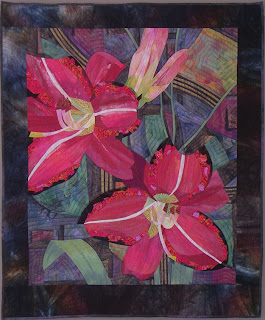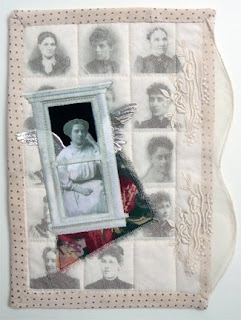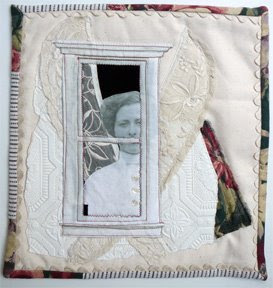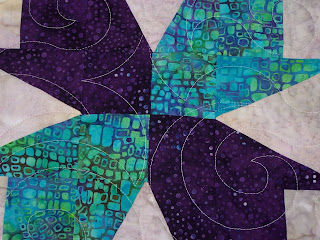 Susan Lenz found her way from custom framer to artist via Julia Cameron's "The Artist's Way." And it wasn't until recently that she stumbled upon the realization that she creates art quilts. The epiphany came while in a cemetery. She's turned her cemetery findings into a series of art quilts that presents the past for us to consider now and in the future. [ Photo: Grave Rubbings Quilt "17 Killed Instantly"] As I post this, she is in England where she just found a grave dated: 1659.
Susan Lenz found her way from custom framer to artist via Julia Cameron's "The Artist's Way." And it wasn't until recently that she stumbled upon the realization that she creates art quilts. The epiphany came while in a cemetery. She's turned her cemetery findings into a series of art quilts that presents the past for us to consider now and in the future. [ Photo: Grave Rubbings Quilt "17 Killed Instantly"] As I post this, she is in England where she just found a grave dated: 1659. Here is Susan Lenz, in her own words:
My name is Susan Lenz.
Like everyone else, I'm many things: wife, daughter, mother, business woman, homeowner, taxpayer, embroiderer......but until last fall I wouldn't have included art quilter.
Working in this new medium is an extension of my love affair with needle and thread as it intersected a particularly inspirational page in Jeanne Williamson's The Uncommon Quilter. On page 85 one can find the following words:
"When you were a child, did you ever make gravestone rubbings?.....rubbing a big crayon over the surface....This same basic technique can be used to create textures on fabric. To make the design
permanent simply iron it in place."
I read this passage while at the MacNamara Foundation artist-in-reside ncy program in the fall of 2008, on Westport Island, Maine. I had been awarded a six week opportunity to simply "make art....all day....everyday". (Heaven!) This was an incredible gift of time; time to explore new ideas, including a secret fascination for the world of art quilts.
ncy program in the fall of 2008, on Westport Island, Maine. I had been awarded a six week opportunity to simply "make art....all day....everyday". (Heaven!) This was an incredible gift of time; time to explore new ideas, including a secret fascination for the world of art quilts.
 ncy program in the fall of 2008, on Westport Island, Maine. I had been awarded a six week opportunity to simply "make art....all day....everyday". (Heaven!) This was an incredible gift of time; time to explore new ideas, including a secret fascination for the world of art quilts.
ncy program in the fall of 2008, on Westport Island, Maine. I had been awarded a six week opportunity to simply "make art....all day....everyday". (Heaven!) This was an incredible gift of time; time to explore new ideas, including a secret fascination for the world of art quilts. Maine is full of old cemeteries and there were several family plots within a short walk. I simply had to try this unique idea, grave rubbings using a crayon on fabric.The first piece was Patience. I used the only plain, light colored fabric I brought to Maine. It was tea-stained muslin that I use for another series called Decision Portraits. Believe it or not, it was there in Maine, reading The Uncommon Quilter and Robert Shaw's definitive 1997 tome The Art Quilt, that I realized the Decision Portraits were all technically "art quilts". I had already finished the first twelve....three layers fastened with stitches! I just didn't recognize them as such!
Somehow the notion of quilting still didn't seem part of my repertoire; yet, collecting more grave rubbings was really appealing. So, I bought a pile of silk remnants and struck out into the local cemeteries. [Photo: Grave rubbings on silk yardage]
I had fantasies of making art with the results. It all seemed so bohemian and exotic --dancing alone in a cemetery with yards of silk fabric and a child's brown crayon. Dreaming about the art quilts I'd make. Letting nature and a sense of eternal peacefulness take control. Somehow, in the autumn sunsets and the picture-perfect setting, I thought this was just wishful thinking.

Logically, I thought I'd regret purchasing the fabric and wasting a perfect afternoon pursuing an idealized image of an "art quilter". I honestly hoped to make art...but never would have bet on actually doing it. The "censor" in the back of my mind chided me...saying, "You'll never really DO anything with all these grave rubbings".But, I did....and I still am....and likely always will be! [Photo: First of the series: Patience]
The Grave Rubbing Series was born from this early experience and is an on-going project.Making the rubbings is a wonderful experience. Collaging them with vintage linens and lace is even better. Meditatively stitching them is simply the best. The kantha styled quilts to which I'd been exposed while attending the Swedish Embroidery Symposium in the summer of 2008 with fiber friend Annica Linsten became my natural approach for these pieces.
Wikipedia's definition is perfect: "Kantha stitching is also used to  make simple quilts. Women in Bengal typically use old saris and cloth and layer them with kantha stitch to make a light blanket or throw or bedspread, especially for children."
make simple quilts. Women in Bengal typically use old saris and cloth and layer them with kantha stitch to make a light blanket or throw or bedspread, especially for children."
 make simple quilts. Women in Bengal typically use old saris and cloth and layer them with kantha stitch to make a light blanket or throw or bedspread, especially for children."
make simple quilts. Women in Bengal typically use old saris and cloth and layer them with kantha stitch to make a light blanket or throw or bedspread, especially for children."[Photos Father Mother Grave Rubbing and (2) below of close ups from Father Mother quilt and 18th Century Angel quilt, showing the traditional Kantha running stitches.]
What appeals to me about this approach to art quilting is the concept of recycling material and stitching by hand. More importantly, words on a gravestone are often selected by those mourning a deceased loved one. They create a memory of the past and are meant to speak to future generations. Using recycled and vintage materials with the rubbings expresses these sentiments perfectly.
Some of the materials I've used include a severely light damaged, heavy curtain salvaged from an old office; a felt c overing used to send a kayak to a local outdoor store (it becomes the batting); damaged card-table clothes, aprons, and household linens; vintage buttons and lace; and even an old sepia photograph of an unknown little girl. Most of the pieces are stitched by both hand and free motion machine embroidery.
overing used to send a kayak to a local outdoor store (it becomes the batting); damaged card-table clothes, aprons, and household linens; vintage buttons and lace; and even an old sepia photograph of an unknown little girl. Most of the pieces are stitched by both hand and free motion machine embroidery.
 overing used to send a kayak to a local outdoor store (it becomes the batting); damaged card-table clothes, aprons, and household linens; vintage buttons and lace; and even an old sepia photograph of an unknown little girl. Most of the pieces are stitched by both hand and free motion machine embroidery.
overing used to send a kayak to a local outdoor store (it becomes the batting); damaged card-table clothes, aprons, and household linens; vintage buttons and lace; and even an old sepia photograph of an unknown little girl. Most of the pieces are stitched by both hand and free motion machine embroidery. I started entering pieces from the series into national juried exhibitions and have been thrilled with acceptance. Memory is currently on display in Rocky Mount's Imperial Center, part of the all media exhibit juried by Anne Lemanski. Father and Mother will be in Art Quilts Lowell 2009 at the Brush Gallery in Lowell, Massachusetts from August 5 through September 19 but earlier w as awarded "Best of Show" in the South Carolina fine craft show "Palmetto Hands", juror Cynthia Bringle of Penland. The Just By Faith Shall Live Again was most recently selected by jurors Eugenia Barnes and gallery director Roger Smith into the 2009 National Small Art Quilt Works exhibition in Groton, NY, July 23 through September 6.
as awarded "Best of Show" in the South Carolina fine craft show "Palmetto Hands", juror Cynthia Bringle of Penland. The Just By Faith Shall Live Again was most recently selected by jurors Eugenia Barnes and gallery director Roger Smith into the 2009 National Small Art Quilt Works exhibition in Groton, NY, July 23 through September 6.
 as awarded "Best of Show" in the South Carolina fine craft show "Palmetto Hands", juror Cynthia Bringle of Penland. The Just By Faith Shall Live Again was most recently selected by jurors Eugenia Barnes and gallery director Roger Smith into the 2009 National Small Art Quilt Works exhibition in Groton, NY, July 23 through September 6.
as awarded "Best of Show" in the South Carolina fine craft show "Palmetto Hands", juror Cynthia Bringle of Penland. The Just By Faith Shall Live Again was most recently selected by jurors Eugenia Barnes and gallery director Roger Smith into the 2009 National Small Art Quilt Works exhibition in Groton, NY, July 23 through September 6. With all this, I've had to readjust my thinking: I am an art quilter!
Other Grave Rubbing Series quilts have been submitted for other exhibitions; I'm waiting on results. It is very, very exciting; and yet, the best is that the series is on-going. I've created additional rubbings in Colma, California....a city with seventeen cemeteries; Hollywood Cemetery in Richmond, Virginia; in the military cemeteries in Arlington and San Francisco; in two pet cemeteries; in Magnolia Cemetery in Charleston; and elsewhere. I haven't even started with the large cemetery only two and a half blocks from my house! [Photo Grave Rubbings quilt "The Just by Faith Shall Live Again."]
These quilts will also be part of a solo show I'm mounting at Gallery 80808/Vista Studios next February. This location is an artist cooperative setting with thirteen studios and a large, professional exhibition area. My studio is there.
of a solo show I'm mounting at Gallery 80808/Vista Studios next February. This location is an artist cooperative setting with thirteen studios and a large, professional exhibition area. My studio is there.
 of a solo show I'm mounting at Gallery 80808/Vista Studios next February. This location is an artist cooperative setting with thirteen studios and a large, professional exhibition area. My studio is there.
of a solo show I'm mounting at Gallery 80808/Vista Studios next February. This location is an artist cooperative setting with thirteen studios and a large, professional exhibition area. My studio is there. The rental agreement entitles me to two free weeks of gallery use. Earlier this year I mounted CYBER FYBER, an international fiber show celebrating the global supportive community of Internet connected fiber artists. These were my "two free weeks" for 2009. Though I'd hoped to mount CYBER FYBER 2 in 2010, funding realities forced me to cancel almost immediately.
In its place, I decided to have my own show: Last Words and the Blues. Blues Chapel, an earlier installation, will fill the main gallery. It will have just returned from two months in the Greater Denton Gallery of Art in Denton, Texas. Blues Chapel transforms a space into a sacred setting focusing on twenty-four early female Blues singers....complete with church pews, triptychs, an altar, and plenty of fiber art. Since I've already "built the church", I'm now at work on the adjoi ning "cemetery". My vision includes the Grave Rubbing Quilt series coupled with a hanging installation of collected epitaphs free motion embroidered on the sheerest chiffon. These will be in the 80808 Gallery atrium.
ning "cemetery". My vision includes the Grave Rubbing Quilt series coupled with a hanging installation of collected epitaphs free motion embroidered on the sheerest chiffon. These will be in the 80808 Gallery atrium.
I can hardly wait to see the art quilts together, creating the peaceful, serene environment that I feel when collecting the rubbings and stitching each work.
[Lenz's photo by Brett Flashnick, freelance photojournalist. Photo taken at Cyber Fyber.]







.jpg)









 e and return shipping may be paid with paypal or personal check. The exhibit is making an effort to eliminate some waste by taking out the requirement to send CDs and print out paper for entry forms. All the information on how to prepare your images for submissions can be found in the
e and return shipping may be paid with paypal or personal check. The exhibit is making an effort to eliminate some waste by taking out the requirement to send CDs and print out paper for entry forms. All the information on how to prepare your images for submissions can be found in the 






